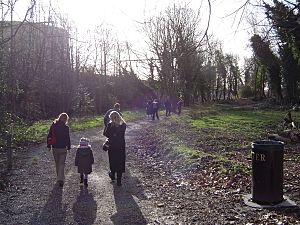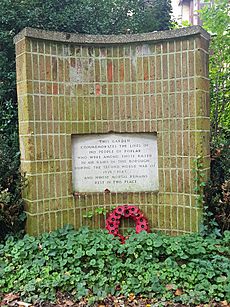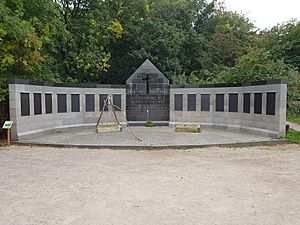Tower Hamlets Cemetery Park facts for kids

Monuments in Tower Hamlets Cemetery
|
|
| Details | |
|---|---|
| Established | 1841 |
| Location | |
| Country | England |
| Type | Public |
| Owned by | Tower Hamlets London Borough Council |
| Size | 10.93 hectares (27.0 acres) |
| No. of interments | 350,000 |
Tower Hamlets Cemetery Park is a special place in the East End of London. It's a historic cemetery that has also become a local nature reserve. People often call it one of London's "Magnificent Seven" cemeteries.
This park first opened in 1841. It was used for burials until 1966. Since then, more land has been added, making it even bigger.
It was originally called the City of London and Tower Hamlets Cemetery. But local people just called it Bow Cemetery. The park is named after the old Tower Hamlets area, which was much larger than the modern borough. The border between the Mile End and Bromley-by-Bow areas runs right through the park. Mile End is on the west side, and Bromley-by-Bow is on the east.
Contents
Finding Tower Hamlets Cemetery Park
The main entrance to the park is on Southern Grove, near Hamlets Way. You can also find smaller gates on Hamlet Way and Cantrell Road.
The closest underground stations are Mile End and Bow Road.
A Look at the Park's Past
Before the Victorian era, most people in London were buried in small churchyards. These places became very crowded and were close to where people lived. This caused problems with diseases and dirty water.
To fix this, a special law was passed. It allowed companies to buy land and create large cemeteries outside the main city. Seven big cemeteries were built around the same time, between 1832 and 1841. These are known as the "Magnificent Seven." Highgate Cemetery is one of the most famous. Others include Nunhead, West Norwood, Kensal Green, Brompton, and Abney Park.
The company that created Tower Hamlets Cemetery was made up of eleven wealthy business owners. They bought about 27 acres (109,265 m2) of land. The cemetery was split into two parts: one for Anglican burials and another for all other religions.
The Bishop of London officially opened Tower Hamlets Cemetery on September 4, 1841. The very first burial happened that same afternoon.
Tower Hamlets Cemetery became very popular with people from the East End. By 1889, over 247,000 people had been buried there. The cemetery stayed open for another 77 years. In the early years, many burials were in "public graves." These graves belonged to the company and were for families who couldn't afford to buy their own plot. Several unrelated people might be buried in the same grave within a few weeks. Some graves were said to be 40 feet deep and held up to 30 bodies!
The cemetery didn't stay neat and tidy for long. Just 55 years after it opened, people reported it was being neglected. During World War II, the cemetery was bombed five times. Both of its chapels were damaged. You can still see marks from bomb shrapnel on graves near the Soanes Centre.
Burials continued until 1966. At that time, the Greater London Council bought the cemetery. They wanted to turn it into an open space for everyone to enjoy. However, local people strongly disagreed with some of the plans, and there wasn't enough money to clear all the graves.
Tower Hamlets Park Today
Tower Hamlets London Borough Council took over the park in 1986. In May 2000, it was named a Local Nature Reserve. This means it's a special place for nature. It's also recognized as a very important place for wildlife in London. The tall brick walls around the park are protected historic structures. Seven individual memorials inside the park are also listed as important historical items.
The Friends of Tower Hamlets Cemetery Park is a group that helps manage the park. They started in 1990 because they were worried about the park being neglected. Their main goal is to encourage more people to use this green space in the city. They also want to protect its amazing variety of plants and animals.
Today, the cemetery looks like a natural woodland. Many different birds and insects live there. You can still see lots of old gravestones and monuments. The Friends group has created several trails and walks for visitors to explore.
The Soanes Centre
The Soanes Centre is located on the west side of the park in Mile End. It's home to Setpoint London East, an organization that offers workshops for students. These workshops help kids learn about science and technology.
The building is right next to the Southern Grove entrance, across from the Soanes family grave. The Friends of Tower Hamlets Cemetery Park also have their office here.
Famous People Buried Here
Many interesting people are buried or have memorials at Tower Hamlets Cemetery Park. Here are a few:
- Charlie Brown: A famous pub owner from Limehouse.
- Major John Buckley VC: A brave soldier who received the Victoria Cross for his actions in the Indian Rebellion of 1857.
- Will Crooks: A trade union leader and the first Labour Mayor of Poplar.
- Clara Grant OBE: Known as "The Bundle Woman of Bow," she was an educator and social reformer. A local school is named after her.
- Alexander Hurley: A singer and comedian, and the second husband of famous performer Marie Lloyd.
- Charles Jamrach: An animal supplier who provided animals to circuses like P. T. Barnum's.
- Alfred Linnel: He died after being trampled by a police horse during a protest. His funeral was organized by famous activists Annie Besant and William Morris.
- Dr Rees Ralph Llewellyn
- Robert McLachlan: An early expert in insects.
- Henry Norris: A civil engineer who worked on the Eddystone Lighthouse and built the first lighthouse designed for an electric light.
- John Northey: Died in the terrible Princess Alice disaster in 1878.
- Hannah Maria Purcell: The wife of William Purcell, a carpenter who was on the famous ship HMS Bounty.
- John "White Hat" Willis: Son of the founder of a shipping company that owned the famous ship Cutty Sark.
Other important memorials include:
- Some victims of the Bethnal Green Disaster.
- A monument for children who were cared for by the charity of Thomas Barnardo. These children were buried in unmarked graves elsewhere in the cemetery.
- Graves of the Charterhouse Brothers, who were monks.
- French graves, for French workers who came to London to refine gold.
- The Blitz Memorial, which remembers those who died in The Blitz. It's made from bricks of damaged buildings.
- The Westwood Monument: For Joseph Westwood (father and son), who were involved in the iron industry and built iron ships.
- The War Memorial, located near the Southern Grove entrance.
War Graves
There are 279 service members from both World Wars buried here. Their names are listed on bronze panels near the Southern Grove entrance. Four Dutch merchant sailors are also remembered here. Nine British merchant sailors are buried here who died when their ship, SS Bennevis, was bombed on September 7, 1940. This happened during an air raid in World War II while their ship was in the West India Docks.




